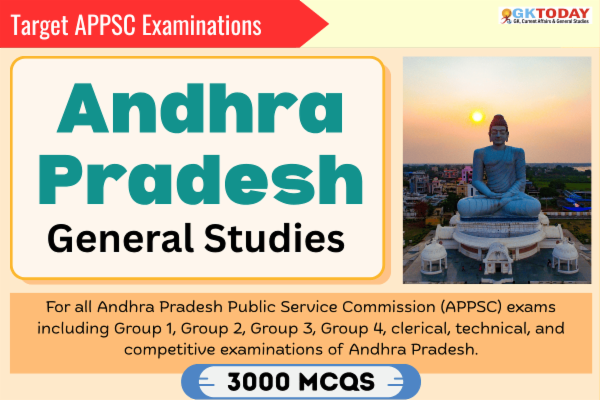States PCS: Andhra Pradesh GK For APPSC Examinations
For all Andhra Pradesh Public Service Commission (APPSC) exams including Group 1, Group 2, Group 3, Group 4, clerical, technical, and competitive examinations of Andhra Pradesh.
41. What was the smallest administrative unit during the Satavahana period in present-day Andhra Pradesh?
[A] Mandal
[B] Janapada
[C] Vishaya
[D] Gramam (Village)
Show Answer
Correct Answer: D [Gramam (Village)]
Notes:
During the Satavahana period, the basic administrative and revenue unit was the village (gramam), overseen by a grama sabha and gramika.
42. Although the Salankayanas, who ruled coastal Andhra during the 5th–6th centuries CE, were known as staunch Shaivas (Paramaheswaras) and Vaishnavas (Paramabhagavatas), which significant Vedic ritual did they perform to legitimize their sovereignty?
[A] Rajasuya Yaga
[B] Vajapeya Yaga
[C] Asvamedha Yaga
[D] Agnihotra Ritual
Show Answer
Correct Answer: C [Asvamedha Yaga]
Notes:
The Salankayanas, despite being dedicated Shaivas and Vaishnavas, performed the Asvamedha Yaga (horse-sacrifice) as recorded in inscriptions at Bhattiprolu and Kalamalla, emulating earlier Satavahana imperial rituals for political legitimacy.
43. Which prominent minister under Kakatiya ruler Ganapati Deva was known by the titles Aruvela Dushaka, Suryavamsa Pratishthana Charya, and Kanchi Churakara?
[A] Erra Timmanayaka
[B] Rudra Danda Nayaka
[C] Kataya Vema Reddy
[D] Prola Bheema Nayaka
Show Answer
Correct Answer: D [Prola Bheema Nayaka]
Notes:
Prola Bheema Nayaka served Ganapati Deva as minister, bearing titles like Aruvela Dushaka, Suryavamsa Pratishthana Charya, and Kanchi Churakara, as noted in Palampet and Banajipet inscriptions.
44. Who was Errana, the last poet of the ‘Kavitrayam’, and whose court did he serve as a poet?
[A] Errana was the court poet of Prolaya Vema Reddy, founder of the Kondaveedu Reddy dynasty in Andhra Pradesh.
[B] Errana was the court poet of Rani Rudrama Devi of Kakatiya dynasty in Telangana.
[C] Errana was the court poet of Krishnadevaraya of the Vijayanagara Empire in Karnataka.
[D] Errana was the court poet of Vishnuvardhana of Western Chalukya dynasty in Karnataka.
Show Answer
Correct Answer: A [Errana was the court poet of Prolaya Vema Reddy, founder of the Kondaveedu Reddy dynasty in Andhra Pradesh.]
Notes:
Errana completed Tikkana’s work in Andhra Mahabharatam, served Prolaya Vema Reddy of Kondaveedu (Andhra Pradesh), and is known as “Prabandha Pitamaha.”
45. Which of the following ports were significant maritime centers during the Ikshvaku dynasty in ancient Andhra Pradesh?
[A] Kakinada and Machilipatnam
[B] Vizagapatnam and Nellore
[C] Motupalli and Ghantasala
[D] Kadapa and Rajahmundry
Show Answer
Correct Answer: C [Motupalli and Ghantasala]
Notes:
Motupalli and Ghantasala, located on the Kakinada coast and near Vijayawada respectively, were key ports of the Ikshvaku dynasty, fostering trade with Southeast Asia and Rome in the 3rd–4th centuries CE.
46. What does the third-century CE inscription of Upasika Bodhisri at Nagarjunakonda reveal about the patronage of Buddhism during the Ikshvaku dynasty?
[A] It shows only royal men sponsored Buddhist viharas in Andhra region.
[B] It provides evidence of Hindu temples established by Ikshvakus in Guntur district.
[C] It highlights that Jainism was the dominant religion under the Ikshvakus.
[D] It confirms significant royal and lay female patronage for Mahayana Buddhism in Andhra under Ikshvakus.
Show Answer
Correct Answer: D [It confirms significant royal and lay female patronage for Mahayana Buddhism in Andhra under Ikshvakus.]
Notes:
The inscription proves both royal and lay female support for Mahayana Buddhist establishments at Nagarjunakonda, demonstrating the Ikshvaku dynasty’s and Andhra’s key roles in Buddhist development.
47. Who was the author of the renowned Telugu literary work “Malapalli,” which significantly influenced modern Telugu literature?
[A] Unnava Laxminarayana
[B] Kandukuri Veeresalingam
[C] Gurajada Apparao
[D] Rayaprolu Subba Rao
Show Answer
Correct Answer: A [Unnava Laxminarayana]
Notes:
Unnava Laxminarayana, born in Krishna district, Andhra Pradesh, authored “Malapalli” in 1916; it pioneered progressive, rural, and reformist themes in modern Telugu literature.
48. Who among the following was popularly referred to as “Harikantha Pitamaba” in Andhra Pradesh?
[A] Kaviraju Tripuraneni Ramaswamy
[B] Gurajada Apparao
[C] Adibhatla Narayana Dasu
[D] Sri Sri (Srirangam Srinivasa Rao)
Show Answer
Correct Answer: C [Adibhatla Narayana Dasu]
Notes:
Adibhatla Narayana Dasu (1863–1945) from Andhra Pradesh was titled “Harikantha Pitamaba” for standardizing Telugu Harikatha and composing over 500 Kathakalakshepam narratives, greatly influencing the region’s devotional literature and storytelling traditions.
49. Who directed “Bhakta Prahlada” (1932), recognized as the first Telugu talkie film?
[A] K. V. Reddy
[B] B. N. Reddy
[C] L. V. Prasad
[D] H. M. Reddy
Show Answer
Correct Answer: D [H. M. Reddy]
Notes:
H. M. Reddy directed “Bhakta Prahlada” (1932), the first Telugu sound film, pioneering talkies in Telugu cinema.
50. After Hindi, which language has the largest number of native speakers in India?
[A] Bengali
[B] Marathi
[C] Telugu
[D] Tamil
Show Answer
Correct Answer: C [Telugu]
Notes:
Telugu, mainly spoken in Andhra Pradesh and Telangana, is the second most spoken native language after Hindi in India, with over 80 million speakers and classical language status since 2008.

